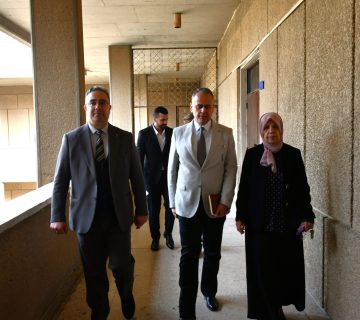Environmental Engineering Department at the College of Engineering, University of Baghdad, held PhD dissertation examination titled:
“Decolorization of Textile Dyes Using Batch and Continuous Systems by an Immobilized Laccase Enzyme Produced from Fenugreek seeds”
By the student Younis Swadi Tlaiaa and supervised Prof.Dr. Mohanned Jasim Mohammed Ridha and Assist.Prof.Dr. Sahar Irhyam Hussien on Wednesday 17/4/2024, in the Environmental Engineering discussion hall. The examination committee consisted of Prof.Dr. Shahla Ismail Ibrahim as Chairman, and the membership of Prof.Dr. Abeer Ibrahim Musa, Prof.Dr. Ahmed Hasson Ali, Prof.Dr. Ziad Tariq Abd Ali and Assist.Prof.Dr. Hussien Majeed Faleeh. After conducting the public discussion and listening to the student’s defense, the dissertation was accepted. It was summarized as follows:
This study delves into the efficient decolorization of aqueous solution containing Reactive Navy Blue (RNB), Reactive Turquoise Blue (RTB), Reactive Red (RR), and Reactive Black (RB) dyes by employing plant laccase immobilized on Porcelanite rocks (PC) by batch and continuous systems. Thirty-six common plants were screened which have the greatest level of laccase enzyme specific activity. It revealed that the enzymatic activity of fenugreek seeds was the highest in comparison with other plants. The optimal enzyme-specific activity was 5340.38 units per milligram protein which were obtained by extracting the enzyme from the ground seeds at a ratio of 1:40 (w:v) with a sodium phosphate buffer at a concentration of 0.02 M and pH 8.0 at 210 minutes. The enzyme yield was 27.6% after extraction and purification by gel filtration using Sephacryl S-300 after 1.01 purification fold. The optimum circumstances for enzymatic activity and stability were found by using sodium acetate (0.1 M) at pH 5 as a buffer. Also, the maximal activity and stability of purified laccase was obtained at 20 °C for 15 min using o-tolidine as a substrate. When the partially purified enzyme was incubated with solutions containing ions of KCl, CuSO4, FeSO4, CaCO3, and ZnSO4 at concentrations of 5 mM and 10 mM respectively, the enzyme’s activity increased. The enzyme is still active when exposed to EDTA and cysteine, however it is inhibited when exposed to HgCl2 ions. Next, compare the effectiveness of the crude and purified laccase enzymes in eliminating the four dyes. With pure laccase, RB had the greatest degradation capacity under the same reaction conditions, with a maximum elimination extent of 98.6%. Following with elimination efficiencies of 92.3, 89, and 84.1%, respectively, were RNB, RTB, and RR dye. However, crude laccase destroys colors with roughly the same efficiency as purified enzyme. When laccase was immobilized on porcelainite using the covalent linking approach, the crude enzyme’s activity and stability were shown to be higher than those of other supporting materials. In order to attain its 98% value, thermostone, garnet, and lime stone came in second, third, and fourth, respectively, with 95.77, 90.22, and 87.28% under the identical immobilization conditions. In the batch system, the impact of several process parameters, including pH, particle amount, dye concentration, and temperature was investigated to optimize the performance of the enzymatic treatment process. Under the optimized protocol, maximum decolorization rates of 95.50% RB, 90.19% for RNB, 85.63% for RTB, and 80.82% for RR were achieved by using 1.5 g of Porcelanite in 30 mg L−1 of dyes at 25 ◦C, pH= 5 after 24 hours. Additionally, immobilized enzyme support materials before and after dye elimination were visualized near-surface by Scanning electron microscopy and surface composition via Fourier transform infrared spectroscopy (FTIR). Statistical tests were used to evaluate regression coefficients, model quality, and the significance of component interactions. With a p-value of less than 0.001, an ANOVA test verified the relevance of the model. The results showed that the dyes RR, RB, RNB, and RTB had coefficients of determination (R2) of 87%, 82%, 87%, and 72%, respectively. For these dyes, the adjusted coefficient of determination (R2 adj) was found to be 84%, 78%, 84%, and 67%, in that order. Variations in the packed bed reactor’s flow rate (0.5, 2, 3) ml/min, immobilized enzymatic bed height (5, 7.5, 10) cm, and starting concentration (30, 40, 50) mg/l were carried out in a continuous system. It was discovered that these ideal parameters were 0.5 ml/min, 10 cm for bed height, and 30 mg/L, in that order. Analysis of Variance (ANOVA) results in the continuous mode system showed that the quadratic model could be applied, with a highly significant model, P-values below 0.05. The (R2) for, RB, RNB, RTB, and RR dyes was found to be 65%, 63%, 88%, and 78%, respectively. The adjusted coefficient of determination (R2 adj) for these dyes was determined as 65%, 61%, 87%, and 78%, respectively. The decolorization percentage for a mixture of four dyes reached up to 95.37%. To evaluate the degradation process, the toxicity decrease percent for the solution was also measured. The final phase of the experiment involved assessing how well an immobilized packed bed bioreactor performed on actual industrial wastewater from the Al-Kut textile factory. The outcomes showed a high degree of agreement with the results of synthetic wastewater, with an 89% decolorization percentage. Regarding Kinetics of laccase when using dyes as substrate, the Michaelis constant (Km) value of the immobilized enzyme was found to be 1100,310,280, and 249 (mol/m3) for RB, RNB, RTB, and RR respectively, while the Maximum reaction rate (Vmax) value was observed to be 0.25,0.51,6.2, and12.7(mol/ m3. s) for RB, RNB, RTB, and RR respectively. The subsequent phase was numerically simulating the continual removal of dyes from a bed using CFD techniques and the Comsol program, version 6.1, to simulate chemical or enzymatic reactions in a packed bed. The reaction behavior’s numerical results and the experimental data agreed rather well. Based on the statistical indicators that were used, it was found that the CFD dynamic simulation model always gives results that are very close to reality with a very acceptable percentage of error. However, mean squared error (MSE) are 0.000021,0.000036,0.000011, and 0.000005 for RB, RNB, RTB, and RR. This shows that CFD models can accurately predict the acceleration of packed-bed bioreactor industrialization in wastewater treatment facilities. This study can be considered as another promising method and step in the field of developing the use of plant-derived enzymes to solve pollution problems without negative effects and considering the development of plant-based materials as “green and sustainable” alternatives with low-cost, and raw materials toward pollution risks and provide water sources through biodegradation and recycling techniques the use.
The recommendations of this dissertation:
- Investigating of other source of laccase such as microbial sources.
- Studying the degradation of other pollutants by this enzyme such as hydrocarbon compounds.
- Explore other types of immobilized material.
- Study another enzyme for degradation the pollutants.








